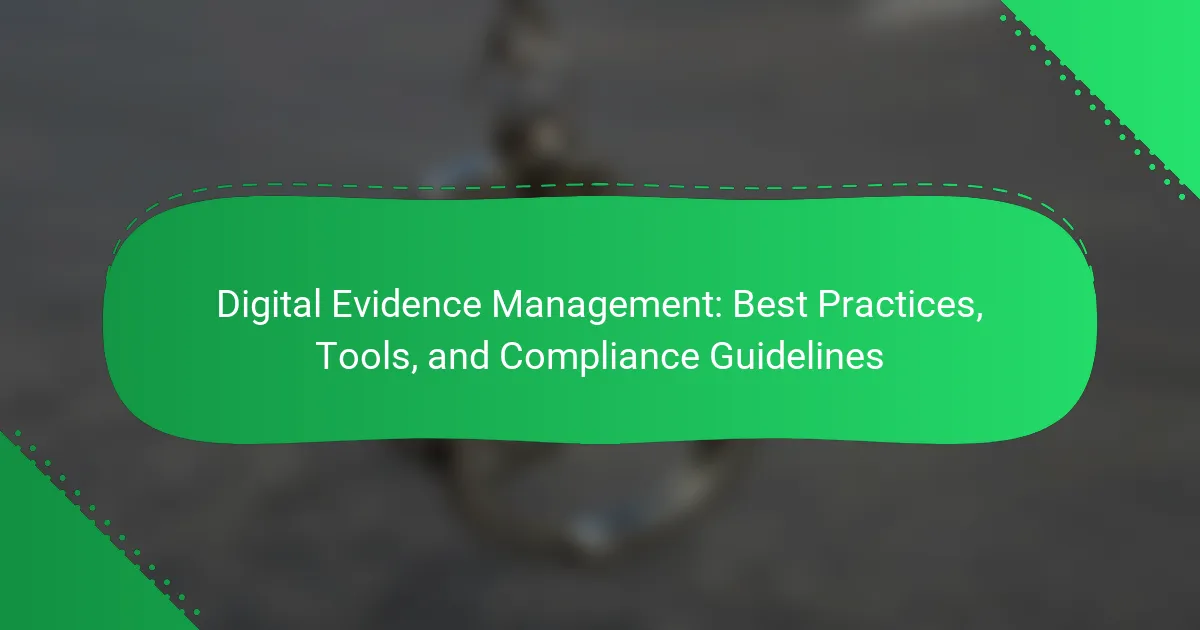Digital Evidence Management is the systematic process of collecting, storing, and analyzing digital evidence, essential for law enforcement and legal entities. This article outlines best practices for managing digital evidence, including establishing a clear chain of custody, ensuring secure storage, and maintaining proper documentation. Key compliance guidelines, such as adherence to legal standards and regular audits, are discussed to ensure the integrity and admissibility of digital evidence in court. Additionally, the article emphasizes the importance of training personnel on relevant protocols and implementing data protection measures to prevent unauthorized access and tampering.

What is Digital Evidence Management?
Digital Evidence Management refers to the systematic process of collecting, storing, and analyzing digital evidence. This process is crucial for law enforcement and legal entities. It ensures the integrity and authenticity of digital data. Effective management includes secure storage and proper documentation. Digital evidence can include emails, documents, images, and videos. Proper procedures prevent data tampering and ensure chain of custody. Studies show that proper digital evidence management improves case outcomes. A 2020 report by the National Institute of Justice emphasizes the importance of these practices in criminal investigations.
How does Digital Evidence Management function in modern investigations?
Digital Evidence Management functions by systematically collecting, preserving, analyzing, and presenting digital evidence in investigations. It involves the use of specialized software tools to ensure data integrity and chain of custody. Digital evidence is collected from various sources, including computers, mobile devices, and cloud services. This evidence is then securely stored in a centralized database.
Access to this database is restricted to authorized personnel only. Digital evidence management systems often include features for tracking the evidence lifecycle. This ensures compliance with legal standards and protocols. Proper documentation and metadata are crucial for maintaining the integrity of the evidence. The use of these systems helps streamline investigations and increases the accuracy of findings.
According to the International Association of Chiefs of Police, effective digital evidence management enhances the overall efficiency of law enforcement operations.
What are the key processes involved in Digital Evidence Management?
The key processes involved in Digital Evidence Management include evidence collection, preservation, analysis, and presentation. Evidence collection involves gathering digital data from various sources, such as computers, mobile devices, and cloud storage. Preservation ensures that the integrity of the digital evidence is maintained during storage and handling. Analysis refers to the examination of the collected data to extract relevant information and insights. Presentation involves organizing and displaying the findings in a clear manner for legal proceedings. These processes are essential to uphold the chain of custody and ensure the admissibility of digital evidence in court.
How is digital evidence collected and preserved?
Digital evidence is collected and preserved through systematic procedures. First, it is crucial to secure the scene and ensure that no data is altered. This includes isolating the device from networks to prevent remote access. Next, forensic tools are utilized to create a bit-for-bit image of the data. This process ensures that an exact replica of the original data is captured without modification.
During collection, proper documentation is maintained, detailing the chain of custody. This documentation includes who collected the evidence, when it was collected, and how it was stored. Preservation involves storing the evidence in a secure environment to prevent tampering.
Digital evidence should be stored in write-protected devices to maintain its integrity. Additionally, regular audits and checks are performed to ensure the evidence remains unaltered. Following these steps aligns with best practices in digital evidence management.
Why is Digital Evidence Management important for law enforcement?
Digital Evidence Management is crucial for law enforcement because it ensures the integrity and accessibility of digital evidence. Proper management helps maintain the chain of custody, preventing tampering or loss of critical data. Law enforcement agencies rely on digital evidence for investigations and prosecutions. Accurate documentation and storage of digital evidence can enhance the credibility of cases in court. According to the International Association of Chiefs of Police, effective digital evidence management can improve case resolution rates. Furthermore, with the increasing reliance on technology in criminal activities, law enforcement must adapt to effectively handle digital evidence. This adaptation is essential for successful investigations and maintaining public trust in the justice system.
What role does Digital Evidence Management play in ensuring justice?
Digital Evidence Management (DEM) plays a crucial role in ensuring justice by preserving the integrity of digital evidence. It provides systematic processes for collecting, storing, and analyzing electronic data. Proper management of digital evidence helps maintain a chain of custody. This ensures that evidence is admissible in court. Accurate documentation of evidence handling reduces the risk of tampering or loss. Studies show that effective DEM can lead to higher conviction rates. For example, a report from the National Institute of Justice highlights that organized digital evidence processes improve case outcomes. Furthermore, compliance with legal standards in DEM fosters public trust in the justice system.
How does Digital Evidence Management impact case outcomes?
Digital Evidence Management significantly impacts case outcomes by ensuring the integrity and accessibility of evidence. Proper management leads to more efficient case processing. It reduces the risk of evidence tampering or loss, which can jeopardize cases. A study by the International Association of Chiefs of Police found that effective digital evidence handling improves conviction rates. Additionally, well-organized digital evidence can expedite investigations. This allows law enforcement to respond more swiftly to incidents. The use of standardized protocols enhances collaboration among agencies. Ultimately, effective digital evidence management contributes to fairer and more reliable judicial outcomes.

What are the best practices for Digital Evidence Management?
Best practices for digital evidence management include establishing a clear chain of custody. This ensures that evidence is tracked from collection to presentation in court. Proper documentation is essential. Each piece of evidence should be logged with details such as time, date, and collector’s identity. Secure storage is crucial. Digital evidence must be stored in a controlled environment to prevent tampering or data loss. Use of encryption is recommended. This protects sensitive information during storage and transfer. Regular audits should be conducted. They help verify that evidence is intact and properly handled. Training personnel on protocols is vital. Staff should be aware of legal and technical standards for handling digital evidence. Compliance with relevant laws and regulations is necessary. This ensures that evidence is admissible in court. Following these practices enhances the integrity and reliability of digital evidence.
How can organizations ensure the integrity of digital evidence?
Organizations can ensure the integrity of digital evidence by implementing strict protocols for evidence collection and handling. This includes using write-blockers to prevent any alteration of data during acquisition. Establishing a chain of custody is essential; it documents who collected, handled, and analyzed the evidence. Regular training for personnel on best practices is crucial to maintain awareness of procedures. Utilizing cryptographic hashing methods verifies that evidence has not been altered. Additionally, secure storage solutions protect evidence from unauthorized access. These measures collectively reinforce the integrity of digital evidence throughout its lifecycle.
What protocols should be followed during evidence collection?
During evidence collection, strict protocols must be followed to ensure integrity and reliability. First, evidence should be collected in a manner that preserves its original state. This includes using appropriate tools and techniques to avoid contamination or alteration. Second, proper documentation is essential. Each piece of evidence must be logged with details such as time, date, and location of collection. Third, a chain of custody must be established. This involves tracking who handled the evidence and when. Fourth, evidence should be stored securely. This prevents unauthorized access and potential tampering. Lastly, personnel involved in evidence collection should be trained and knowledgeable about legal standards and procedures. Following these protocols ensures the admissibility of evidence in court.
How can chain of custody be maintained effectively?
Chain of custody can be maintained effectively by following strict protocols for evidence handling. Each piece of evidence must be documented at every stage of its collection, storage, and analysis. This documentation should include details such as who collected the evidence, when it was collected, and how it was transported. Secure storage facilities should be used to prevent unauthorized access. Evidence should be sealed in tamper-proof containers to ensure integrity. Regular audits of evidence storage and handling practices can help identify potential issues. Training personnel on proper evidence management procedures is essential for compliance. Adhering to these practices helps ensure that evidence remains admissible in court.
What tools are available for Digital Evidence Management?
Digital evidence management tools include software and platforms designed to collect, store, and analyze digital evidence. Popular tools in this domain are CaseGuard, FTK Imager, and EnCase. CaseGuard allows for comprehensive case management and evidence tracking. FTK Imager is known for its disk imaging capabilities. EnCase provides advanced forensic analysis features. These tools enhance the efficiency of digital evidence handling. They ensure compliance with legal standards and facilitate accurate investigations.
What are the most commonly used software solutions for managing digital evidence?
The most commonly used software solutions for managing digital evidence include EnCase, FTK (Forensic Toolkit), and X1 Social Discovery. EnCase is widely recognized for its comprehensive digital investigation capabilities. FTK offers robust data processing and analysis features. X1 Social Discovery specializes in collecting and analyzing social media evidence. These tools are essential for law enforcement and legal professionals. Their effectiveness is demonstrated by their widespread adoption in forensic investigations.
How do these tools enhance the efficiency of evidence processing?
These tools enhance the efficiency of evidence processing by automating data collection and analysis. Automation reduces manual errors and speeds up the workflow. Streamlined processes allow for faster retrieval of relevant information. Enhanced search capabilities enable quick identification of critical evidence. Integration with existing systems ensures seamless data transfer. Real-time collaboration features improve communication among team members. Comprehensive tracking and auditing capabilities provide accountability. These factors collectively lead to a more efficient evidence processing system.

What are the compliance guidelines related to Digital Evidence Management?
Compliance guidelines related to Digital Evidence Management ensure the integrity and security of digital evidence. These guidelines include adherence to legal standards, such as the Federal Rules of Evidence in the U.S. They mandate proper chain of custody documentation to track evidence handling. Additionally, organizations must implement data protection measures to prevent unauthorized access or tampering. Regular audits and training for personnel handling evidence are also essential. Compliance with industry standards, like ISO/IEC 27001, supports the establishment of effective information security management systems. Following these guidelines helps maintain the admissibility of evidence in court.
What legal standards must be adhered to in Digital Evidence Management?
Legal standards in Digital Evidence Management include adherence to chain of custody protocols, proper documentation, and compliance with relevant laws. Chain of custody ensures that evidence is collected, preserved, and handled in a way that maintains its integrity. Documentation must detail every action taken with the evidence, including who collected it, how it was stored, and when it was accessed. Compliance with laws such as the Fourth Amendment protects against unlawful searches and seizures. Additionally, organizations must follow guidelines set forth by the Federal Rules of Evidence, which govern the admissibility of electronic evidence in court. These standards ensure that digital evidence is reliable and can be effectively used in legal proceedings.
How does compliance vary across different jurisdictions?
Compliance varies across different jurisdictions due to varying laws and regulations. Each jurisdiction has its own legal framework governing digital evidence management. For instance, the European Union implements the General Data Protection Regulation (GDPR), which imposes strict data handling requirements. In contrast, the United States has a patchwork of federal and state laws that can differ significantly. Some states have enacted specific data privacy laws, while others rely on federal guidelines. Additionally, international treaties can influence compliance standards, creating further complexity. This inconsistency affects how organizations manage digital evidence and adhere to legal requirements. Therefore, understanding local regulations is crucial for effective compliance in digital evidence management.
What are the consequences of non-compliance in Digital Evidence Management?
Non-compliance in Digital Evidence Management can lead to severe legal and operational consequences. Evidence may be deemed inadmissible in court, compromising legal cases. This can result in wrongful convictions or acquittals. Organizations may face penalties, including fines and sanctions from regulatory bodies. Additionally, non-compliance can damage an organization’s reputation and erode public trust. It may also lead to increased scrutiny from law enforcement and oversight agencies. Ultimately, failure to comply can hinder investigations and result in lost opportunities for justice.
What are the emerging trends in Digital Evidence Management?
Emerging trends in Digital Evidence Management include the adoption of cloud-based solutions. These solutions enhance accessibility and collaboration among law enforcement agencies. Artificial intelligence is increasingly used for data analysis and evidence categorization. This technology improves efficiency and accuracy in handling digital evidence. Blockchain technology is being explored for maintaining the integrity of digital evidence. It provides an immutable record of evidence handling and chain of custody. Mobile evidence collection tools are becoming more prevalent. They enable on-scene data capture, which speeds up the investigation process. Additionally, there is a growing emphasis on data privacy and compliance with regulations. Agencies are focusing on training personnel in digital evidence handling to meet evolving standards.
How is technology evolving to support better evidence management?
Technology is evolving to support better evidence management through advanced data storage solutions and enhanced security measures. Cloud-based systems allow for scalable storage and easy access to evidence. Artificial intelligence is being utilized to analyze and categorize evidence more efficiently. Blockchain technology offers secure and tamper-proof records of evidence handling. Mobile applications enable real-time evidence collection and documentation from the field. Integration with existing law enforcement systems streamlines workflows and reduces human error. These advancements lead to improved accountability and transparency in evidence management processes.
What future challenges might impact Digital Evidence Management practices?
Future challenges that might impact Digital Evidence Management practices include evolving technology, data privacy concerns, and legal compliance issues. Rapid advancements in technology can outpace current management systems, making them obsolete. Increased data generation from various sources complicates storage and retrieval processes. Privacy regulations, such as GDPR, impose strict requirements on data handling and storage. Compliance with these regulations is essential to avoid legal repercussions. Cybersecurity threats pose risks to the integrity and confidentiality of digital evidence. Ensuring robust security measures is critical to protect sensitive information. Additionally, the need for standardization across jurisdictions can create inconsistencies in evidence handling. These challenges require ongoing adaptation and innovation in Digital Evidence Management practices.
What practical tips can enhance Digital Evidence Management practices?
Implementing standardized protocols can enhance Digital Evidence Management practices. These protocols ensure consistency in handling digital evidence. Utilizing a secure chain of custody is crucial. This prevents tampering and maintains the integrity of the evidence. Regular training for personnel on best practices is essential. It keeps staff updated on the latest techniques and technologies. Employing robust encryption methods protects sensitive data. This reduces the risk of unauthorized access. Utilizing specialized software for evidence tracking improves organization. It allows for efficient retrieval and management of digital files. Regular audits of the evidence management process can identify weaknesses. Addressing these weaknesses strengthens the overall system.
Digital Evidence Management (DEM) is the systematic process of collecting, storing, and analyzing digital evidence essential for law enforcement and legal proceedings. This article outlines best practices for effective DEM, including maintaining chain of custody, proper documentation, and secure storage methods. It also discusses the tools available for managing digital evidence, compliance guidelines to ensure legal adherence, and emerging trends in the field. Additionally, the article highlights the importance of training personnel and the consequences of non-compliance in maintaining the integrity of digital evidence.



